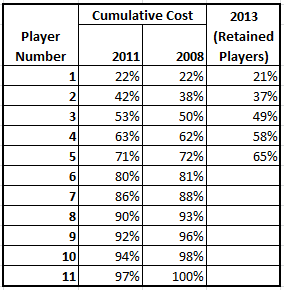I have a proprietary algorithm for evaluating cricket matches. This algorithm analyzes matches ball-by-ball and then computes the “impact” of each player on the game, in terms of both batting and bowling.
I’ve been intending to do this for a while now but I finally got down to calculating the impact of different players in the past editions of the IPL, and who it makes sense for franchises to retain (incidentally, today is the last day for franchises to announce to the IPL who the players are who they are going to retain).
Let us go franchise by franchise and see who the best players are. The numbers in the brackets represent the impact of each player according to my proprietary system.
1. Chennai Super Kings
By a long way, their two best players are MS Dhoni (3.53) and Ravindra Jadeja (3.46). Interestingly, the primary reason for the latter’s high score is his batting (2.86)- he has been bowling well, too (0.6), but it is his batting that has had significant impact.
These two are followed some distance behind by Raina (2.02) and the now retired Mike Hussey (1.75). Ashwin is some way behind at 0.7 (his bowling is at 1 and batting at 0.33; the algorithm tends to unfairly penalize bowlers for their batting abilities, or the lack of it).
Chennai have already made their decision on who to retain. They are going to retain Dhoni, Jadeja, Raina, Ashwin and Dwayne Bravo. The last is a bit of a puzzle, at -1.09. His batting has been excellent – he has contributed 1.52 but his bowling has been utter crap at 2.61. CSK would do well to use him as a batsman only
2. Delhi Daredevils
This is a team that has performed rather badly in the last bunch of IPLs, so they might be expected to dispense with some players. Virender Sehwag (3.14), though, has performed exceptionally in the rot, though this season’s domestic performance (or the lack of it) might go against him. Next is the injury-prone Irfan Pathan (1.72). Shahbaz Nadeem is a surprise package at 1.56. I wouldn’t expect them to retain anyone.
Umesh Yadav (-1.77) and Mahela Jayawardene (-2.33) have been especially poor performers
3. Kings XI Punjab
Another franchise that didn’t do particularly well in the last set of IPLs. David Miller (2.05) was their standout performer, followed by Gurkeerat Singh (1.24), Shaun Marsh (1.11) and Praveen Kumar (1.02). The latter two are highly injury prone and they may not want to part with a large part of their budget for the yet uncapped Gurkeerat. So if you expect them to retain any players, it would only be Miller.
At the other end, Parvinder Awana (-1.92) has been the standout performer.
4. Kolkata Knight Riders
Sunil Narine (4.48) and Gautam Gambhir (4.22) tower over the rest. Following them are Shakib al Hasan (1.63) and Iqbal Abdulla (1.13). One would expect them to hold on to the first two (Narine and Gambhir) and try to use their trump card to match a price for Shakib.
Jacques Kallis performed particularly badly (-2.81) and is unlikely to be retained.
5. Mumbai Indians
If you were to rank all players in descending order of impact, the standout player across teams would be Harbhajan Singh (5.04; 3.64 bowling, 1.41 batting). Despite his axing from the national team, one would expect him to be retained by the franchise. He is followed some way behind by Lasith Malinga (2.01), Kieron Pollard (1.97; with 3.05 in batting and – 1.09 in bowling) and Rohit Sharma (1.74). One would expect all of those three to be retained. Dinesh Karthik at 1.31 might also be retained, for they will only need to give up Rs. 4 Crore from their salary cap to get him.
6. Rajasthan Royals
If one goes by the gossip, the Royals are expected to retain a large number of players. They are the “moneyball” team of the IPL. They don’t spend too much on salary but try to get otherwise undervalued players to play for them.
Brad Hodge (1.91) has been their star performer but his age might go against him – they might prefer to match him using their trump card. They are expected to retain Shane Watson (1.55 with 3.83 batting and -2.28 bowling), though. Stuart Binny at 1.34 is also a good bet to be retained.
Interestingly, the system shows a negative impact for the otherwise highly rated Sanju Samson (-0.17)! He is, however, another player they might retain.
7. Royal Challengers Bangalore
The Royal Challengers have already made their decision – they will retain Chris Gayle (4.93; with 6.51 batting and -1.58 bowling), AB de Villiers (3.12) and Virat Kohli (1.95 with 2.22 batting and -0.27 bowling). The one highly rated player they are not retaining is Zaheer Khan (3.69). Khan has been exceptional considering that his partners in the RCB pace attack are Vinay Kumar (-3.59), RP Singh (-2.83) and Abhimanyu Mithun (-1.69).
Their only other highly rated bowler is Murali Kartik (1.05). They will need to completely rebuild their bowling attack in order to compete this IPL
8. Sunrisers Hyderabad
Dale Steyn (3.43) is the standout performer and they would do well to retain him. The next best is Shikhar Dhawan, who is some distance away at 0.72. Given the paucity of quality Indian players, though, they might end up retaining Dhawan also.
I’m willing to share the full results of my analysis. Do reach out to me if you want to play around with it and I’ll send it to you. And let me know what you think of these ratings.











